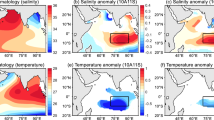Abstract
Interannual variations in the surface and subsurface tropical Indian Ocean were studied using HadISST and SODA datasets. Wind and heat flux datasets were used to discuss the mechanisms for these variations. Our results indicate that the surface and subsurface variations of the tropical Indian Ocean during Indian Ocean Dipole (IOD) events are significantly different. A prominent characteristic of the eastern pole is the SSTA rebound after a cooling process, which does not take place at the subsurface layer. In the western pole, the surface anomalies last longer than the subsurface anomalies. The subsurface anomalies are strongly correlated with ENSO, while the relationship between the surface anomalies and ENSO is much weaker. And the subsurface anomalies of the two poles are negatively correlated while they are positively correlated at the surface layer. The wind and surface heat flux analysis suggests that the thermocline depth variations are mainly determined by wind stress fields, while the heat flux effect is important on SST.
Similar content being viewed by others
References
Annamalai, H., Murtugudde, R., Poremra, J., Xie, S. P., Liu, P., and Wang, B., 2003. Coupled dynamics over the Indian Ocean: spring initiation of the Zonal Mode. Deep-Sea Res. II, 50: 2305–2330.
Behera, S. K., Salvekar, P. S., and Yamagata, T., 2000. Simulation of interannual SSTvariability in the tropical Indian Ocean. J. Clim., 13: 3487–3489.
Carton, J., Chepurin, G., Cao, X., and Giese, B., 2000. A simple ocean data assimilation analysis of the global upper ocean 1950–95. Part I: Methodology. J. Phys. Oceanogr., 30: 294–309.
Chao, J. P., Yuan, S. Y., and Cai, Y., 2003. Large-scale air-sea interaction in the tropical Indian Ocean. Acta Meteorol. Sin., 61(2): 251–256.
Drbohlav, H. L., Gaualdi, S., and Navarra, A., 2007. A diagnostic study of the Indian Ocean dipole mode in El Nino and non-El Nino years. J. Clim., 20: 2961–2977.
Du, Y, Xie, S.-P, Huang, G., and Hu, K.-M., 2009. Role of air-sea interaction in the long persistence of El Niño-induced North Indian Ocean warming. J. Clim., 22: 2023–2038.
Guan, Z., and Yamagata, T., 2003. The unusual summer of 1994 in East Asia: IOD teleconnections. Geophys. Res. Lett., 30, 1544, doi: 10.1029/2002GL016831.
Hong, C. C., Liu, M. M., and Kanamitsu, M., 2008. Temporal and spatial characteristics of positive and negative Indian Ocean dipole with and without ENSO. J. Geophys. Res., 113, D08107, doi: 10.1029/2007JD009151.
Kalnay, E., Kanamitsu, M., Kistler, R., Collins, W., Deaven, D., Gandin, L., et al., 1996. The NCEP/NCAR 40-year reanalysis project. Bull. Am. Meteorol. Soc., 77: 437–471.
Li, T., Zhang, Y., Lu, E., and Wang, D., 2002. Relative Role of Dynamic and Thermodynamic Processes in the Development of the Indian Ocean Dipole: An OGCM Diagnosis. Geophys. Res. Lett., 29(23), 2110, doi: 10.1029/2002GL015789.
Li, T., Wang, B., Chang, C. P., and Zhang, Y. S., 2003. A theory for the Indian Ocean dipole-zonal mode. J. Atmos. Sci., 60: 2119–2135.
Liu, Q. Y., Wang, D. X., and Xie, Q., 2002. First CEOF mode of the thermal structure in the Indian Ocean, J. Geosci. Chin., 4(2): 45–56.
Nicholls, N., 1989. Sea Surface temperatures and Australianwinter rainfall. J. Clim., 2: 965–973.
Prasad, T. G., and McClean, J. L., 2004. Mechanisms for anomalous warming in the western Indian Ocean during dipole mode events. J. Geophys. Res., 109, C02019, doi: 10.1029/2003JC001872.
Rao, S. A., Behera, S. K., Masumoto, Y., and Yamagata, T., 2002. Interannual subsurface variability in the tropical Indian Ocean with a special emphasis on the Indian Ocean Dipole. Deep-Sea Res.II, 49: 1549–1572.
Rao, S. A., Masson, S., Luo, J. J., Behera, S. A., and Yamagata, T., 2007. Termination of Indian Ocean dipole events in a coupled general circulation model. J. Clim., 20: 3018–3034.
Rayner, N. A., Parker, D. E., Horton, E. B., Folland, C. K., Alexander, L. V., Rowell, D. P., et al., 2003. Global analyses of sea surface temperature, sea ice, and night marine air temperature since the late nineteenth century. J. Geophys. Res., 108(D14), 4407.
Saji, N. H., Goswami, B. N., Vinayachandran, P. N., and Yamagata, T., 1999. A dipole mode in the tropical Indian Ocean. Nature, 401: 360–363.
Saji, N. H., and Yamagata, T., 2003. Possible impacts of Indian Ocean dipole events on global climate. Clim. Res., 25: 151–169.
Shinoda, T., Hendon, H. H., and Alexander, M. A., 2004. Surface and subsurface dipole variability in the Indian Ocean and its relation with ENSO. Deep-Sea Res. II, 51: 619–635.
Tokinaga, H., and Tanimoto, Y., 2004. Seasonal transition of SST anomalies in the tropical Indian Ocean during El Niño and Indian Ocean dipole years. J. Meteorol. Soc. Jpn., 82: 1007–1018.
Venzke, S., Latif, M., and Villwock, A., 2000. The coupled GCM ECHO-2. Part II: Indian Ocean response to ENSO. J. Clim., 13: 1371–1383.
Webster, P. J., Moore, A, M., Loshnigg, J. P., and Leben, R. R., 1999. Coupled ocean-atmosphere dynamics in the Indian Ocean during 1997–1998. Nature, 401: 356–360.
Xie, S. P., Annamalai, H., and Schott, F. A., 2002. Structure and mechanisms of south Indian Ocean climate variability. J. Clim., 15: 867–878.
Yuan, D. L., and Liu, H. L, 2009. Long-wave dynamics of sea level variations during Indian Ocean dipole events. J. Phys. Oceanogr., 39: 1115–1132.
Author information
Authors and Affiliations
Corresponding author
Rights and permissions
About this article
Cite this article
Sun, S., Lan, J. & Wang, Y. Variations of SST and thermocline depth in the tropical Indian Ocean during Indian Ocean Dipole events. J. Ocean Univ. China 9, 129–134 (2010). https://doi.org/10.1007/s11802-010-0129-2
Received:
Revised:
Accepted:
Published:
Issue Date:
DOI: https://doi.org/10.1007/s11802-010-0129-2




